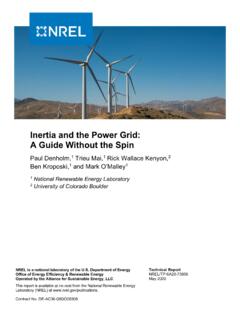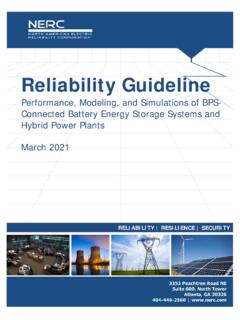Transcription of Grid-Scale Battery Storage - NREL
1 | INTEGRATION TOOLKITGrid- scale Battery StorageFrequently Asked Questions1. For information on Battery chemistries and their relative advantages, see Akhil et al. (2013) and Kim et al. (2018).2. For example, Lew et al. (2013) found that the United States portion of the Western Interconnection could achieve a 33% penetration of wind and solar without additional Storage resources. Palchak et al. (2017) found that India could incorporate 160 GW of wind and solar (reaching an annual renewable penetration of 22% of system load) without additional Storage is Grid-Scale Battery Storage ? Battery Storage is a technology that enables power system operators and utilities to store energy for later use. A Battery energy Storage system (BESS) is an electrochemical device that charges (or collects energy) from the grid or a power plant and then discharges that energy at a later time to provide electricity or other grid services when needed.
2 Several Battery chemistries are available or under investigation for Grid-Scale applications, including lithium-ion, lead-acid, redox flow, and molten salt (including sodium-based chemistries).1 Battery chemistries differ in key technical characteristics (see What are key characteristics of Battery Storage systems?), and each Battery has unique advantages and disadvantages. The current market for Grid-Scale Battery Storage in the United States and globally is dominated by lithium-ion chemistries (Figure 1). Due to tech-nological innovations and improved manufacturing capacity, lithium-ion chemistries have experienced a steep price decline of over 70% from 2010-2016, and prices are projected to decline further (Curry 2017).Increasing needs for system flexibility, combined with rapid decreases in the costs of Battery technology, have enabled BESS to play an increasing role in the power system in recent years.
3 As prices for BESS continue to decline and the need for system flexibility increases with wind and solar deployment, more policymakers, regulators, and utili-ties are seeking to develop policies to jump-start BESS Grid-Scale Battery Storage needed for renewable energy integration? Battery Storage is one of several technology options that can enhance power system flexibility and enable high levels of renewable energy integration. Studies and real-world experience have demonstrated that interconnected power systems can safely and reliably integrate high levels of renewable energy from variable renewable energy (VRE) sources without new energy Storage There is no rule-of-thumb for how much Battery Storage is needed to integrate high levels of renewable energy. Instead, the appropriate amount of Grid-Scale Battery Storage depends on system-specific characteristics, including: The current and planned mix of generation technologies Flexibility in existing generation sources Interconnections with neighboring power systems The hourly, daily, and seasonal profile of electricitydemand, and The hourly, daily, and seasonal profile of current andplanned many systems, Battery Storage may not be the most economic resource to help integrate renewable energy, and other sources of system flexibility can be explored.
4 Additional sources of system flexibility include, among others, building additional pumped-hydro Storage or transmission, increasing conventional generation flexibility, and changing operating procedures (Cochran et al. 2014).Figure 1: utility- scale Battery Storage capacity by chemistry (2008-2017). Data source: Energy Information Administration, Form EIA-860, Annual Electric Generator ReportAnnual Installed CapacityChemistryEnergy (MWh)Power (MW)Year Installed050100150200250'17'16'15'14'13' 12'11'10'09'08'17'16'15'14'13'12'11'10'0 9'08 Lithium-IonOtherRedox FlowLead-acidSodium-based2 Grid-Scale Battery Storage : Frequently Asked QuestionsWhat are the key characteristics of Battery Storage systems? Rated power capacity is the total possible instantaneous discharge capability (in kilowatts [kW] or megawatts [MW]) of the BESS, or the maximum rate of discharge that the BESS can achieve, starting from a fully charged state.
5 Energy capacity is the maximum amount of stored energy (in kilowatt-hours [kWh] or megawatt-hours [MWh]) Storage duration is the amount of time Storage can discharge at its power capacity before depleting its energy capacity. For example, a Battery with 1 MW of power capacity and 4 MWh of usable energy capacity will have a Storage duration of four hours. Cycle life/lifetime is the amount of time or cycles a Battery Storage system can provide regular charging and discharging before failure or significant degradation. Self-discharge occurs when the stored charge (or energy) of the Battery is reduced through internal chemical reactions, or without being discharged to perform work for the grid or a customer. Self-discharge, expressed as a percentage of charge lost over a certain period, reduces the amount of energy available for discharge and is an important parameter to consider in batteries intended for longer-dura-tion applications.
6 State of charge, expressed as a percentage, represents the Battery s present level of charge and ranges from completely discharged to fully charged. The state of charge influences a Battery s ability to provide energy or ancillary services to the grid at any given time. Round-trip efficiency, measured as a percentage, is a ratio of the energy charged to the Battery to the energy discharged from the Battery . It can represent the total DC-DC or AC-AC efficiency of the Battery system, including losses from self-discharge and other electrical losses. Although Battery manufacturers often refer to the DC-DC efficiency, AC-AC efficiency is typically more important to utilities, as they only see the Battery s charging and discharging from the point of interconnection to the power system, which uses AC (Denholm 2019).
7 What services can batteries provide? Arbitrage: Arbitrage involves charging the Battery when energy prices are low and discharging during more expensive peak hours. For the BESS operator, this practice can provide a source of income by taking advantage of electricity prices that may vary throughout the day. One extension of the energy arbitrage service is reducing renewable energy curtailment. System operators and project developers have an interest in using as much low-cost, emissions-free renewable energy generation as possible; however, in systems with a growing share of VRE, limited flexibility of conventional generators and temporal mismatches between renewable energy supply and electricity demand ( , excess wind 3. See Mills and Wiser (2012) for a general treatment on the concept of capacity in the middle of the night) may require renewable generators to curtail their output.
8 By charging the Battery with low-cost energy during periods of excess renewable generation and discharging during periods of high demand, BESS can both reduce renewable energy curtailment and maximize the value of the energy developers can sell to the market. Another extension of arbitrage in power systems without electricity markets is load-leveling. With load-levelling, system opera-tors charge batteries during periods of excess generation and discharge batteries during periods of excess demand to more efficiently coordinate the dispatch of generating Capacity or Peaking Capacity: System operators must ensure they have an adequate supply of generation capacity to reliably meet demand during the highest-demand periods in a given year, or the peak demand. This peak demand is typically met with higher-cost generators, such as gas plants; however, depending on the shape of the load curve, BESS can also be used to ensure adequate peaking generation capacity.
9 While VRE resources can also be used to meet this requirement, these resources do not typically fully count toward firm capacity, as their generation relies on the availability of fluctuating resources and may not always coincide with peak demand. But system operators can improve VRE s ability to contribute to firm capacity requirements through pairing with BESS. Pairing VRE resources with BESS can enable these resources to shift their generation to be coincident with peak demand, improving their capacity value (see text box below) and system Reserves and Ancillary Services: To maintain reliable power system operations, generation must exactly match electricity demand at all times. There are various categories of operating reserves and ancillary services that function on different timescales, from subsec-onds to several hours, all of which are needed to ensure grid reliability.
10 BESS can rapidly charge or discharge in a fraction of a second, faster Firm Capacity, Capacity Credit, and Capacity Value are important concepts for understanding the potential contribution of utility- scale energy Storage for meeting peak demand. Firm Capacity (kW, MW): The amount of installed capacity that can be relied upon to meet demand during peak periods or other high-risk periods. The share of firm capacity to the total installed capacity of a generator is known as its capacity credit (%).3 Capacity Value ($): The monetary value of the contribution of a generator (conventional, renewable, or Storage ) to balancing supply and demand when generation is Battery Storage : Frequently Asked Questionsthan conventional thermal plants, making them a suitable resource for short-term reliability services, such as Primary Frequency Response (PFR) and Regulation.

















